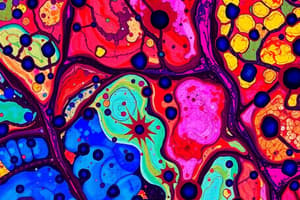Podcast
Questions and Answers
What type of granules are found in nerve cells that can be highlighted using Toluidine blue stain?
What type of granules are found in nerve cells that can be highlighted using Toluidine blue stain?
- Nissl granules (correct)
- Mitochondrial granules
- Glycogen granules
- Mast granules
Which cells contain exogenous and endogenous granules?
Which cells contain exogenous and endogenous granules?
- Muscle cells
- Liver cells
- Macrophages (correct)
- Skin cells
What type of acini are associated with mucous secretion?
What type of acini are associated with mucous secretion?
- Skeletal acini
- Mucous acini (correct)
- Serous acini
- Pancreatic acini
Which structures are primarily stained by the Silver stain technique?
Which structures are primarily stained by the Silver stain technique?
Which type of cells are characterized by the presence of pigment granules?
Which type of cells are characterized by the presence of pigment granules?
What type of tissue is specifically mentioned to have different types of epithelium?
What type of tissue is specifically mentioned to have different types of epithelium?
What type of cells is primarily involved in the formation of blood platelets?
What type of cells is primarily involved in the formation of blood platelets?
Which structure is characterized by the presence of rough endoplasmic reticulum?
Which structure is characterized by the presence of rough endoplasmic reticulum?
What is the relationship between centimeters and millimeters?
What is the relationship between centimeters and millimeters?
Which part of the Light Microscope is responsible for magnification?
Which part of the Light Microscope is responsible for magnification?
What is the purpose of cedar oil in microscopy?
What is the purpose of cedar oil in microscopy?
What is the maximum magnification achievable using a Transmission Electron Microscope?
What is the maximum magnification achievable using a Transmission Electron Microscope?
How do you calculate the total magnification of a histological section using a Light Microscope?
How do you calculate the total magnification of a histological section using a Light Microscope?
What type of image does a Scanning Electron Microscope provide?
What type of image does a Scanning Electron Microscope provide?
Which of the following microscopes offers the highest magnification?
Which of the following microscopes offers the highest magnification?
What characterizes the Oil Immersion Objective in a Light Microscope?
What characterizes the Oil Immersion Objective in a Light Microscope?
What is the primary objective of the histology textbook?
What is the primary objective of the histology textbook?
Which significant enhancement was notably included in the new edition of the book?
Which significant enhancement was notably included in the new edition of the book?
How does the textbook approach the relationship between structure and function?
How does the textbook approach the relationship between structure and function?
What aspect of genetics does the textbook focus on?
What aspect of genetics does the textbook focus on?
What has been improved in the new edition concerning illustrations?
What has been improved in the new edition concerning illustrations?
What is one of the new inclusions in the textbook that reflects current trends in medicine?
What is one of the new inclusions in the textbook that reflects current trends in medicine?
Who contributed significantly to the book aside from the author?
Who contributed significantly to the book aside from the author?
The new edition makes efforts to provide what type of illustrations?
The new edition makes efforts to provide what type of illustrations?
What is the function of neurotransmitter receptors found in the postsynaptic membrane?
What is the function of neurotransmitter receptors found in the postsynaptic membrane?
Which type of connective tissue surrounds the entire nerve trunk?
Which type of connective tissue surrounds the entire nerve trunk?
What is a unique feature of spinal ganglia?
What is a unique feature of spinal ganglia?
What effect does the arrival of a nerve impulse have at the synapse?
What effect does the arrival of a nerve impulse have at the synapse?
Which type of ganglion is characterized by stellate-shaped nerve cells?
Which type of ganglion is characterized by stellate-shaped nerve cells?
What happens to the myelin sheath during staining with osmic acid?
What happens to the myelin sheath during staining with osmic acid?
What is the role of satellite cells surrounding nerve cells in ganglia?
What is the role of satellite cells surrounding nerve cells in ganglia?
What forms the central structure within each nerve fiber in a stained transverse section of a nerve trunk?
What forms the central structure within each nerve fiber in a stained transverse section of a nerve trunk?
What type of nerve cells predominantly compose spinal ganglia?
What type of nerve cells predominantly compose spinal ganglia?
Which of the following statements accurately describes sympathetic ganglia?
Which of the following statements accurately describes sympathetic ganglia?
How are the nerve cells in spinal ganglia arranged compared to those in sympathetic ganglia?
How are the nerve cells in spinal ganglia arranged compared to those in sympathetic ganglia?
What separates the nerve cells in sympathetic ganglia?
What separates the nerve cells in sympathetic ganglia?
What role do ependymal cells play in the central nervous system?
What role do ependymal cells play in the central nervous system?
Which type of neuroglia is responsible for supporting the neuron population in the central nervous system?
Which type of neuroglia is responsible for supporting the neuron population in the central nervous system?
What feature distinguishes the shape of nerve cells in spinal ganglia from those in sympathetic ganglia?
What feature distinguishes the shape of nerve cells in spinal ganglia from those in sympathetic ganglia?
Which characteristic is true regarding the number of satellite cells in spinal ganglia compared to sympathetic ganglia?
Which characteristic is true regarding the number of satellite cells in spinal ganglia compared to sympathetic ganglia?
Flashcards are hidden until you start studying
Study Notes
### Types of Microscopes
-
Light Microscope (LIM):
- Uses daylight or electric light for illumination
- Magnifies objects up to 450 times
- Different magnifying powers available (5x, 10x, 15x)
-
Electron Microscope (EM):
- Utilizes a beam of electrons for illumination
- Produces highly magnified images (up to 100,000 times)
-
Scanning Electron Microscope:
- Creates 3D images of examined samples (e.g., red blood cells, cilia)
-
Atomic Force Microscope:
- Magnifies fresh tissues up to 500,000 times
Measuring Units in Histology
- 1 centimeter (cm) = 10 millimeters (mm)
- 1 millimeter (mm) = 1000 micrometers (µm) or 1000 microns (µ)
- 1 micrometer (µm) = 1000 nanometers (nm)
- 1 nanometer (nm) = 10 Angstroms (Å)
### Neuroglia
- Supporting tissue of CNS, instead of connective tissue
- Stainable with silver or gold chloride
Neuroglia Types
-
Neuroglia Proper:
- Macroglia (Astrocytes): Protoplasmic and Fibrous
- Microglia (Mesoglia): Mesodermal origin
- Oligodendroglia: Few dendrites
-
Other Supporting Cells:
- Ependymal Cells:
- Simple cuboidal, ciliated cells lining the spinal cord's central canal and brain ventricles
- Derived from spongioblast cells
- Produce Cerebrospinal Fluid (CSF)
- Satellite Cells:
- Small cells surrounding nerve cells in the brain and ganglia
- Ependymal Cells:
### Synapse Structure
- Pre-synaptic membrane: Neuron's axon terminal
- Synaptic cleft: Space between pre and post synaptic membranes
- Post-synaptic membrane: Neuron's dendrites with neurotransmitter receptors
- Gemmules or Spines: Small projections from pre and post synaptic membranes
Synapse Functions
- Arrival of nerve impulse releases chemical transmitter into the synaptic cleft - Transmitted information either excites or inhibits the post-synaptic membrane
### Peripheral Nerve Trunk Structure
- Axons bundled together
- Surrounded by connective tissue (CT)
- Epineurium: Outer CT fascia
- Endoneurium (Henle's sheath): CT surrounding each axon
- Myelin sheaths appear black with osmic acid stain
### Nerve Ganglia
- Collections of nerve cells and fibers surrounded by CT
- Types: Spinal and Autonomic (Sympathetic and Parasympathetic)
Spinal Ganglia
- Located at both sides of the spinal cord
- Relay sensations
- Contain pseudo-unipolar nerve cells
- Each neuron has a convolution called a glomerulus
- Surrounded by satellite cells
- Covered by a thick capsule
Sympathetic Ganglia
- Form a sympathetic chain or isolated ganglia throughout the body
- Relay motor functions from spinal cord to body organs
- Contain multipolar, stellate-shaped nerve cells
Differences Between Spinal and Sympathetic Ganglia
- Spinal Ganglia:
- Located at dorsal roots of spinal cord
- Thick CT capsule
- Pseudo-unipolar cells
- Large or small cells (20-120 µm)
- Cells in groups or rows
- Groups separated by myelinated nerve fibers
- Rounded cells in cross section
- Few cells per ganglion
- Axons convoluted at beginning, forming a glomerulus
- More satellite cells
- No synapse between neurons
- Poor blood supply
- Sympathetic Ganglia:
- Located at sympathetic chain
- Thin CT capsule
- Multipolar, stellate-shaped cells
- Mostly small cells (30 µm)
- Scattered cells
- Cells separated by non-myelinated nerve fibers
- Irregular cells in cross section
- Many cells per ganglion
- No intracellular glomerulus
- Fewer satellite cells
- Synapse between neurons
- Rich blood supply
Studying That Suits You
Use AI to generate personalized quizzes and flashcards to suit your learning preferences.




